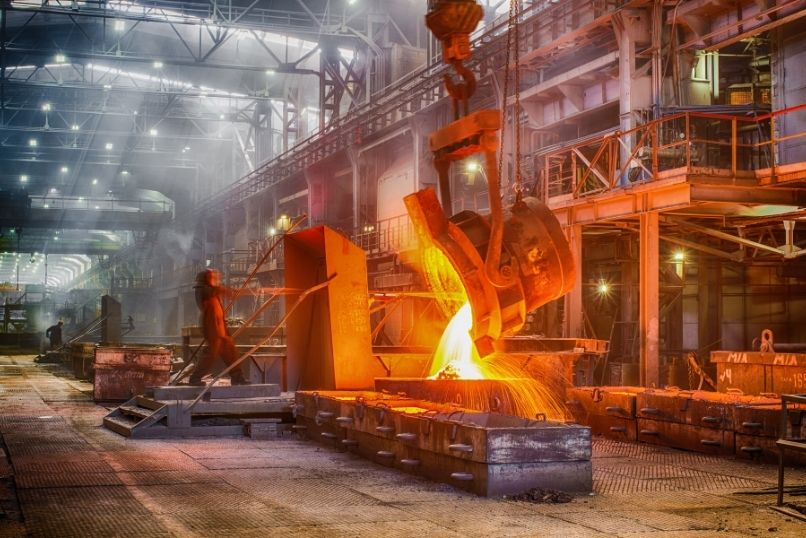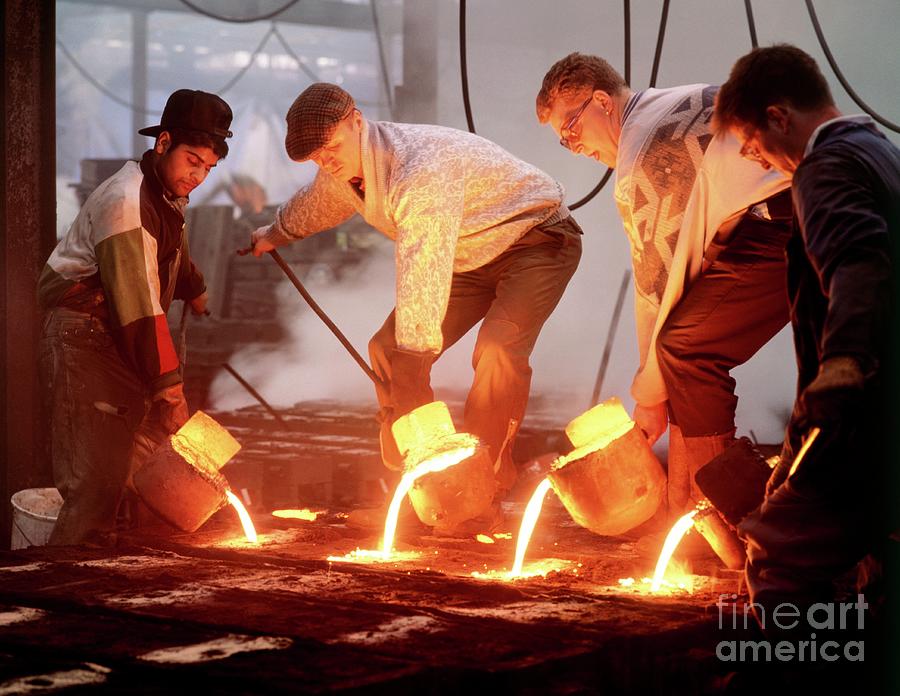Top 5 Reasons to Choose a Metal Foundry for Specialized Projects
Wiki Article
All About Metal Casting: Exactly How Foundries Provide Top Quality and Precision in Manufacturing
Metal casting stands as a fundamental process in production, where raw metals are changed right into particular elements. Foundries utilize various casting approaches to achieve preferred attributes and shapes. Each approach includes its very own collection of benefits and constraints. Recognizing these nuances is necessary for appreciating how top quality and precision are preserved throughout the procedure. The discussion in advance will check out the elaborate dynamics of metal casting and its importance across several industries.The Fundamentals of Metal Casting
Metal casting is a basic process in making that entails forming molten metal right into wanted types. This essential technique starts with the choice of raw products, commonly various metal alloys, which are thawed in a heater. When the metal gets to the proper temperature level, it becomes ready and liquid for casting.The procedure needs a mold and mildew, usually made from sand, metal, or ceramic, which defines the last form of the cast object. As soon as the molten metal is poured into the mold and mildew, it solidifies and cools, taking on the mold's contours.
After cooling, the casting is gotten rid of from the mold, and any type of necessary completing procedures, such as trimming or polishing, are conducted. This approach enables makers to produce intricate forms and components with high precision and marginal waste. Metal casting is extensively utilized throughout different industries, from auto to aerospace, underscoring its importance in modern production.
Kinds of Casting Approaches
While various casting approaches exist, each technique offers special advantages and is fit for various applications. Sand casting, one of one of the most usual techniques, uses sand as the mold and mildew product, permitting huge parts and complex designs. Financial investment casting, understood for its precision, employs a wax pattern coated in ceramic, making it optimal for complex geometries. Die casting, which includes requiring liquified metal into molds under high stress, is often utilized for automation of small, thorough elements. Furthermore, shell molding incorporates sand and resin to create thinner, extra accurate molds, improving surface area coating. An additional approach, continual casting, enables the production of lengthy lengths of metal shapes, improving production procedures. Each of these techniques plays a critical role in the metal casting market, dealing with details needs from production volume to create complexity, thus adding to the diversity of applications across various markets.The Function of Foundries in Manufacturing
Foundries serve a vital feature in the manufacturing landscape, as they change raw metals into usable elements through numerous casting procedures. These centers employ an array of methods to develop items that fulfill specific specifications, therefore making sure top quality and effectiveness in production (Metal Casting). By using techniques such as sand casting, financial investment casting, and die casting, foundries accommodate varied industries, including automotive, aerospace, and construction
Eventually, shops are important to the production ecological community, supplying vital elements that support a wide selection of applications and markets. Their precision and flexibility drive effectiveness in modern-day manufacturing.
Materials Utilized in Metal Casting
The choice of products utilized in metal casting is necessary for accomplishing the wanted properties and performance of the last product. Various steels such as bronze, aluminum, and iron are generally utilized, each offering distinct advantages. Light weight aluminum is preferred for its lightweight and corrosion-resistant top qualities, making it ideal for automobile and aerospace applications. Iron, especially cast iron, is known for its outstanding fluidness and toughness, appropriate for heavy machinery and facilities components. Bronze, with its exceptional wear resistance, is frequently used in marine environments.Additionally, products such as silica sand are often utilized for mold and mildew production, supplying a fine equilibrium in between durability and ease of shaping. The selection of products also consists of additives like changes, which boost the casting procedure by improving fluidness and lowering oxidation. Eventually, the appropriate selection of these materials considerably affects the effectiveness and high quality of the casting process.
High quality Control in the Casting Refine
Quality assurance in the casting procedure is necessary to guarantee that last products satisfy market standards and specs. Numerous assessment strategies are employed to determine flaws and analyze the honesty of cast components. In addition, adherence to developed certifications and standards improves the reliability and efficiency of actors products.Inspection Techniques Employed
Keeping the integrity of cast metal elements relies heavily on numerous inspection methods. Foundries use aesthetic inspections as an initial action to recognize surface area defects, such as incorporations or splits. Non-destructive screening (NDT) methods, consisting of ultrasonic testing and radiographic inspection, are More Bonuses important for spotting internal flaws without endangering the part's stability. Dimensional examinations using calipers and coordinate measuring machines verify that components meet defined resistances. Furthermore, chemical evaluation validates that the alloy make-up lines up with called for standards. These evaluation methods collectively validate that the castings meet the necessary top quality and performance criteria, ultimately lessening the threat of failure in their designated applications. Executing these extensive examinations is basic for preserving high criteria in metal casting production.Requirements and Certifications
Criteria and accreditations play a crucial duty in the quality assurance of the casting process. Foundries follow different international and industry-specific criteria, such as ISO 9001 and ASTM guidelines, assuring uniformity and dependability in their items. These standards describe the required criteria for products, production techniques, and screening procedures, adding to an extra efficient production procedure. Accreditations, such as AS9100 for aerospace applications, additionally stress the importance of quality control in specialized fields. By acquiring these credentials, shops demonstrate their commitment to excellence, lowering flaws and boosting consumer fulfillment. Regular audits and inspections confirm conformity, fostering constant enhancement and development within the industry. Inevitably, adherence to developed criteria cultivates trust fund between manufacturers and clients.Advancements in Casting Technology

3D Printing Assimilation
Incorporating 3D printing technology right into metal casting procedures is reinventing the production landscape. This innovative fusion enhances the layout and production of intricate geometries that typical approaches battle to attain. By employing additive manufacturing for developing cores and molds, factories can considerably lower preparations and material waste. In addition, 3D printing enables quick prototyping, making it possible for suppliers to evaluate designs swiftly and effectively, thus facilitating iterative improvements. This innovation likewise supports the manufacturing of lightweight elements, which are crucial in markets such as aerospace and vehicle. Consequently, the assimilation of 3D printing not just streamlines procedures but also raises the precision and quality of actors metal items, marking a noteworthy improvement in the industry.Automated Manufacturing Processes
The advancements in 3D printing have actually led the way for additional advancements in automated manufacturing processes within metal casting. Foundries are significantly taking on robotics and automation to improve performance and precision. Automated systems simplify the entire casting discover this process, from mold and mildew development to pouring and completing. Smart sensing units and real-time surveillance enable accurate control of temperatures and product flow, decreasing waste and improving top quality. Furthermore, software application services promote better layout and simulation, allowing suppliers to maximize processes prior to production begins. These automated production procedures not only reduce labor costs however also lessen human error, ensuring regular outcome. As an outcome, the integration of sophisticated innovations in metal casting is revolutionizing manufacturing abilities and satisfying the expanding needs of numerous industries.Advanced Material Advancement
As markets demand higher performance and sustainability, advancements in material development for metal casting are emerging as an important emphasis. Engineers and researchers are exploring new alloys and compounds that improve mechanical buildings while decreasing ecological impact. Technologies consist of light-weight products that preserve toughness, enabling much better gas efficiency in transport applications. Furthermore, the unification of recycled products is coming to be more common, aligning with sustainability objectives. Advanced casting techniques, such as 3D printing and precision molding, allow for the production of intricate geometries that typical methods can not accomplish. These developments not only boost the capability of cast components but additionally boost manufacturing effectiveness. On the whole, the continual development of material science drives the future of metal casting, fulfilling the demands of contemporary industries.
Applications of Metal Casting Across Industries
Metal casting plays a necessary duty in different markets, as it enables the production of complex forms and top notch elements with loved one performance - Metal Casting. In the auto industry, cast metals are essential for producing engine blocks, transmission situations, and other crucial components that need resilience and precision. Aerospace sectors utilize metal casting for components like wind turbine blades and structural aspects, where integrity is extremely importantIn addition, equipment and equipment production take advantage of metal casting by creating equipments, real estates, and other intricate components that improve capability. The building market likewise uses metal casting for architectural attributes, structural supports, and installations, showcasing flexibility.
The medical area relies on cast steels for surgical tools and implants, stressing the need for biocompatibility. Generally, metal casting is a foundational procedure throughout several markets, providing options that fulfill stringent high quality standards and efficiency requirements.
Regularly Asked Inquiries
What Safety And Security Measures Are Taken in Metal Casting Foundries?
In metal casting factories, safety and security steps include protective equipment, ventilation systems, regular tools upkeep, worker training, and emergency procedures to minimize risks connected with heats, harmful products, and potential mishaps during the casting process.Just How Do Foundries Manage Waste and Environmental Influence?
Foundries take care of waste and ecological influence via reusing materials, carrying out filtration systems for exhausts, and sticking to guidelines - Aluminum Casting. They likewise take on lasting techniques, such as lowering energy usage and using green materials in their proceduresWhat Are the Expenses Related To Metal Casting Procedures?
The costs related to metal casting processes include raw materials, labor, devices maintenance, energy consumption, and waste administration. In addition, special info changes in market costs and compliance with ecological laws can greatly influence general expenditures for foundries.Just How Does Metal Casting Compare to Various Other Manufacturing Techniques?
Metal casting uses unique benefits, such as complex shapes and high material effectiveness, contrasted to approaches like machining or marking. It might include longer lead times and greater first prices, depending on task specs.
What Career Opportunities Exist in the Metal Casting Industry?
The metal casting sector uses numerous career possibilities, consisting of factory monitoring, procedure engineering, quality control, mold style, and equipment procedure. Specialists can also seek roles in r & d, sales, and environmental health and wellness.Metal casting stands as a fundamental process in manufacturing, where raw metals are changed right into certain components. Metal casting is a basic process in manufacturing that involves shaping molten metal right into desired types. An additional technique, constant casting, enables the manufacturing of lengthy sizes of metal shapes, streamlining manufacturing processes. The prices associated with metal casting processes include raw products, labor, devices upkeep, power consumption, and waste administration. The metal casting market provides various occupation possibilities, consisting of factory monitoring, process engineering, quality assurance, mold and mildew style, and equipment operation.
Report this wiki page